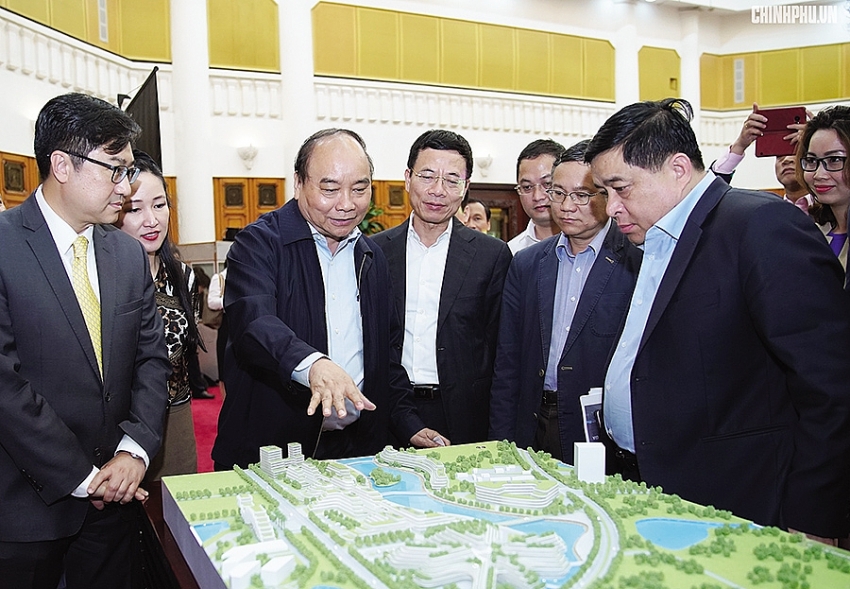Centre to provide hi-tech hub
 |
| The new National Innovation Centre looks poised to develop into a core for a range of cutting-edge companies |
As a German company operating in Vietnam since 1979, Siemens has successfully implemented a series of critical infrastructure projects. Now, the company is an innovation leader across a wide range of sectors.
On hearing about the project for the new National Innovation Centre (NIC), Siemens views this as a new opportunity as the company is confident with the achievements it has had over the years in Vietnam. However, specific information about the project remains meagre. The fields and extent to which foreign investors can participate in the venture are questions for the company for now.
Bosch Vietnam, also from Germany, has been operating a research and development centre for technologies, and a similar centre for automobiles. The company said it would conduct more studies about the project to get involved.
Swedish-backed ABB Vietnam, a pioneering technology leader in power grids, electrification products, industrial automation, and robotics, is also wondering what they need to do to grab this new opportunity. With prioritising fields like smart factories, smart cities, and digital industry, ABB have competitive advantages and will seriously consider investment in the NIC if it comes to pass.
At last week’s meeting on the project, Prime Minister Nguyen Xuan Phuc agreed to speed up the building of the NIC. However, he required the Ministry of Planning and Investment (MPI) to set up a detailed, stringent, and complete roadmap so that the project can be soon approved, and guidelines can soon be released.
According to the plan, the NIC will be located in the Hoa Lac area in western Hanoi, covering 23 hectares. It will be near universities, and scientific and technological companies with available infrastructure investment. The NIC’s construction area is set to be 90,000 square metres, with the total investment capital of VND1.9 trillion ($82.6 million) funded by foreign and domestic investors.
Nguyen Dinh Cung, director of the Central Institute for Economic Management (CIEM), said that the NIC can be focussed on various sectors. Specifically, the centre can be the innovation core for smart manufacturing with smart factory application and product development for future factories with increasing automation.
The centre can also become a place to promote application and development of products and services for smart cities with a sustainable environment. Accordingly, products and services are not limited with urban management and transportation, but also expand to the development and application of environmental technology with innovative business models.
Besides, the centre can also become a new hub to promote digital media, especially digital games based on the available domestic market.
Furthermore, the centre can become a place to develop network security applications for governmental agencies, companies, and individuals with the highest tax priority with 20 years of using land for free. Particularly, the NIC can represent enterprises to rent ground, and proceed with administration procedures and deploy necessary infrastructure investment.
Meanwhile, according to Dang Quang Vinh, deputy director of the CIEM’s Department of Business Environment and Competitive Capacity, the NIC will be the first centre and part of a network of innovation centres that will be set up throughout the country. Each centre will focus on specific areas that can benefit from the locality’s advantages.
“In the first five years, the project expects to attract 40 tech companies, 150 startups, 15 investment funds, 40 companies providing trade services, and create about 5,000 jobs in technology,” Vinh said.
In order to develop this detailed plan, a study group of 100 Vietnamese overseas talents was established by the MPI last August. The project has also been receiving consultancy from US-based Boston Consulting Group and the UK’s Arup Architects.
What the stars mean:
★ Poor ★ ★ Promising ★★★ Good ★★★★ Very good ★★★★★ Exceptional
Related Contents
Latest News
More News
- Global partnerships key to Vietnam’s IFC development (December 26, 2025 | 16:18)
- Vingroup pulls out of bid to invest in North-South high-speed railway (December 26, 2025 | 11:42)
- Strengthening supply chains through trade promotions and customs reform (December 24, 2025 | 14:00)
- PM orders investment model for North–South high-speed rail (December 22, 2025 | 17:43)
- LS Eco Energy to invest in Vietnam rare earth sector (December 22, 2025 | 17:31)
- Government moves to establish International Financial Centre (December 21, 2025 | 21:00)
- Vietnam's IFC to target global investment flows (December 21, 2025 | 18:00)
- Two national hospitals expand capacity with new facilities (December 20, 2025 | 09:00)
- Ha Tinh breaks ground on major Vingroup industrial and energy projects (December 19, 2025 | 18:24)
- EVN launches major power infrastructure projects nationwide (December 19, 2025 | 18:17)

 Tag:
Tag:




















 Mobile Version
Mobile Version